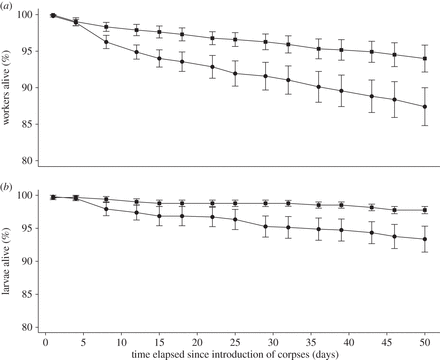July 9, 2014 report
Study shows corpse removal in ant colonies is a survival advantage

(Phys.org) —A trio of researchers in Belgium has found that if red ants are prevented from removing dead ants from inside of their nest, survival rates go down. In their paper published in the journal Biology Letters, Lise Diez, Philippe Lejeune and Claire Detrain describe a study they conducted where they restricted red ants from removing their dead and the impact it had on their survival rates.
It seems intuitive, removing dead bodies from places where social organisms congregate helps those that are still alive, live longer, presumably healthier lives. Dead bodies, after all, attract a host of organisms that feed off of them, some of which might be dangerous for those still living. Scientists have observed social organisms of many different species removing dead bodies from nests on many occasions, but until now, the researchers report, there has been very little research conducted to prove what everyone seems to think is so obvious—that doing so helps those that live there, live longer. To learn more, they focused their efforts on the common red ant (Myrmica rubra) which normally lives in a variety of areas in nests as large as a thousand members. Prior research has found the ants to be highly social with different ants performing different roles, one of which is to keep the nest clean by removing the carcasses of ants that die while inside—they drag and dump them outside. To better understand how carcass removal might benefit the ants, the researchers set up several nests in their lab. Some of the nests had normal sized exits, while others had openings that were so small it was difficult for ants to drag dead ants through.
The researchers placed dead ants in each of the colonies and then monitored mortality rates. They found that such rates rose dramatically in the nests when the ants couldn't remove the dead ants, starting after just eight days. After 50 days, the rate rose on average from 6 percent to 13 percent. They noted that larvae were impacted as well, but not as dramatically—likely, the researchers report, because the dead bodies were moved to locations as far from them as possible inside the nest.
The researchers conclude that removal of dead ants from colonies is an important survival technique.
More information: Keep the nest clean: survival advantages of corpse removal in ants, Biology Letters, Published 9 July 2014 DOI: 10.1098/rsbl.2014.0306
Abstract
Sociality increases exposure to pathogens. Therefore, social insects have developed a wide range of behavioural defences, known as 'social immunity'. However, the benefits of these behaviours in terms of colony survival have been scarcely investigated. We tested the survival advantage of prophylaxis, i.e. corpse removal, in ants. Over 50 days, we compared the survival of ants in colonies that were free to remove corpses with those that were restricted in their corpse removal. From Day 8 onwards, the survival of adult workers was significantly higher in colonies that were allowed to remove corpses normally. Overall, larvae survived better than adults, but were slightly affected by the presence of corpses in the nest. When removal was restricted, ants removed as many corpses as they could and moved the remaining corpses away from brood, typically to the nest corners. These results show the importance of nest maintenance and prophylactic behaviour in social insects.
Journal information: Biology Letters
© 2014 Phys.org



















